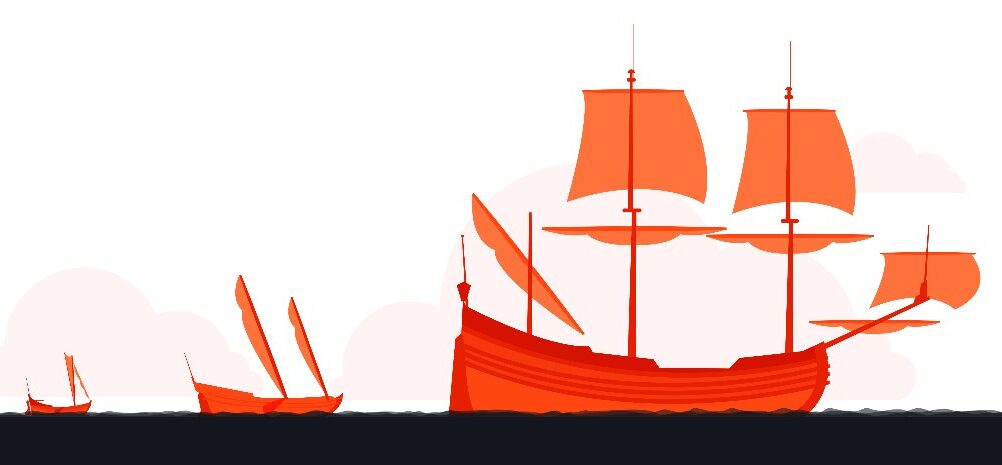How do you approach a megalomaniac experiment like building a 17th century cargo ship from waste plastic? You break it down into small steps. This is how our ship strategy came into being: the ‘evolution of waste plastic ships’.
We are one step closer to our goal! This month we started the construction of the Dutch ‘speeljacht’, one of the first pleasure yachts in maritime history. With the construction of this ship, we discover a new part of the clean route that leads to our dream: the construction of a 17th century Dutch ‘fluitschip’, a merchant ship from waste plastic.
The speeljacht is an intermediate step (or stop) in the ship strategy that we realise at our yard: ‘the evolution of waste plastic ships’. Each ship is an experiment in itself.
The Dutch ‘werkboot’: without one, you had a problem
It all started with our first experiment: building a small Dutch ‘werkboot’ on the way to the flute ship. One and a half year later, we have four of those boats at the yard and we are extremely proud of them. Beautiful historical ships with a crucial role in our ship evolution. Because you don’t just build a flute ship like that: every mega project starts with a first small step, right? Through these ships we got to know the 17th century shipbuilding craft and discovered the characteristics and possibilities of waste plastic as an innovative building material.
Back in the 17th century, the werkboot was also an essential little ship: without these boats the big fluitschip could not sail out. With the these supplier boats, the sailors brought merchandise to and from the coast. It is not without reason that this is one of the most commonly built ships of that time.
Video: see the Dutch werkboot in action
The Dutch ‘speeljacht’: the largest object ever made from waste plastic
Anyone who has visited the shipyard in the past year, has already seen the model of this 17th century pleasure yacht. Or better: experienced it. Although it is just a construction of thin wooden battens, when you stand in it you feel ‘Wow, this thing is big!’ (And we hear you think: ‘Can they build this?!’)
The speeljacht is three times bigger than the four little boats floating next to it. Place the ‘Lankhorst’, the ‘Schelphoek’ and the ‘Karperkuil’ on top of each other and you have an impression of the height. Put them in a row and you have the length. So with the speeljacht we are going next level. Because never before has such a large functional object been built from waste plastic.
An unsuccessful experiment
Not only the size of the ship, also the material is a huge experiment. The larger the ship, the sturdier the material must be. That is why we have been working with the polymer industry for some time now to strengthen PET (plastic from soft drink bottles and meat trays). But no matter how many bright minds we put together, the first experiments proved to be unsuccessful. When we threw a first ‘trial keel’ on the ground, it shattered into a thousand pieces. We can’t (yet) build a seaworthy ship with that. But we might be able to construct a rudder or a lee board.
In addition, new discoveries await us in the field of rigging and clean propulsion. All these experiments do justice to the nature of the speeljacht, which was an innovative ship at the time. It was one of the first pleasure yachts in maritime history. Some merchants were so wealthy that they could afford to build a boat for fun, to ‘play’ (‘speeljacht’ literally means ‘yacht to play’ in Dutch).
They hired a steward to sail them around and showed off the yacht to their competitors and friends (and enemies, who knows). In addition, it had an innovative type of rigging. In short, when sailing a speeljacht, you made quite an impression.
The Dutch fluitschip: let them laugh at us!
And then the ship that it is all about: the massive Dutch ‘fluitschip’. The 17th century cargo ship we will build entirely out of waste plastic. Everyone thinks it’s a great idea, but not everyone takes us seriously. Because ‘building that thing out of waste plastic is impossible.’ (Since that waste plastic is not yet sturdy enough.) And that is exactly why we want to build it.
The inventor of this ship, The Dutch merchant Pieter Jansz, was also laughed at in his time. His ship was quite remarkable, an experiment for the time. But once at sea, this crazy elongated ship turned out to be an excellent merchant ship that brought enormous prosperity to The Netherlands: the Golden Age. ‘Our’ fluitschip is a huge experiment as well. But if we succeed, we will provide sectors such as construction with a new material (from waste) and we will unleash a New Golden Age. So let them laugh at us!
And what if it all doesn’t work out?
We have got it all figured out, but our plans can still fail miserably. But that doesn’t matter, because we stumble our way into the future! We learn along the way, and if we can’t manage to build that thing? Then at least we have a good story to tell.

